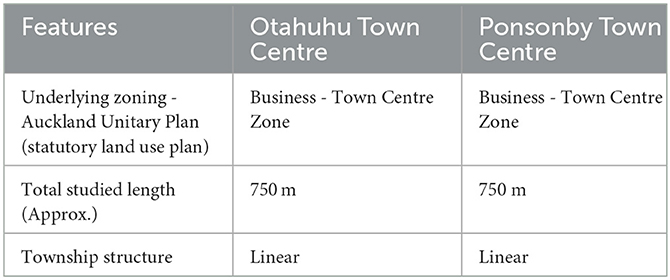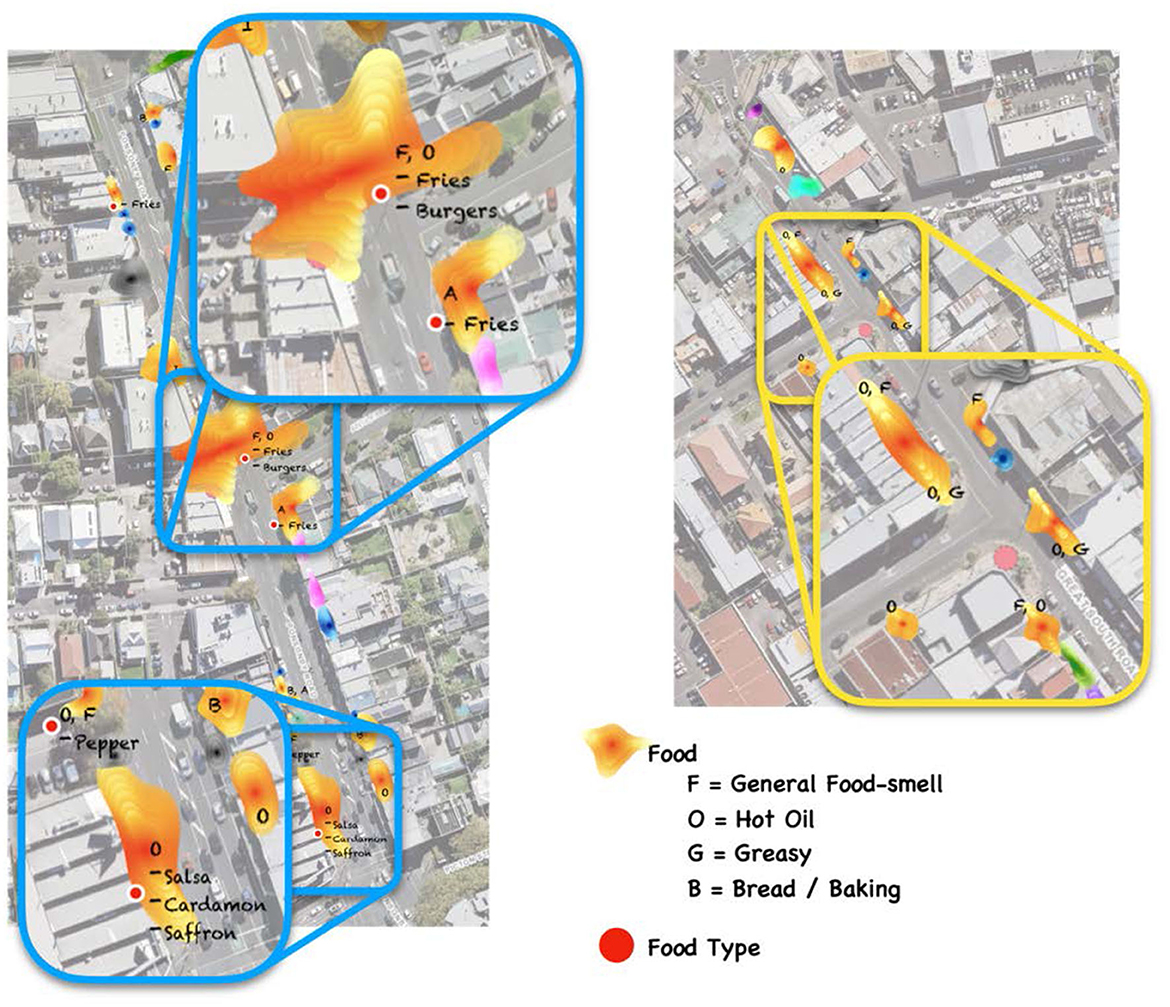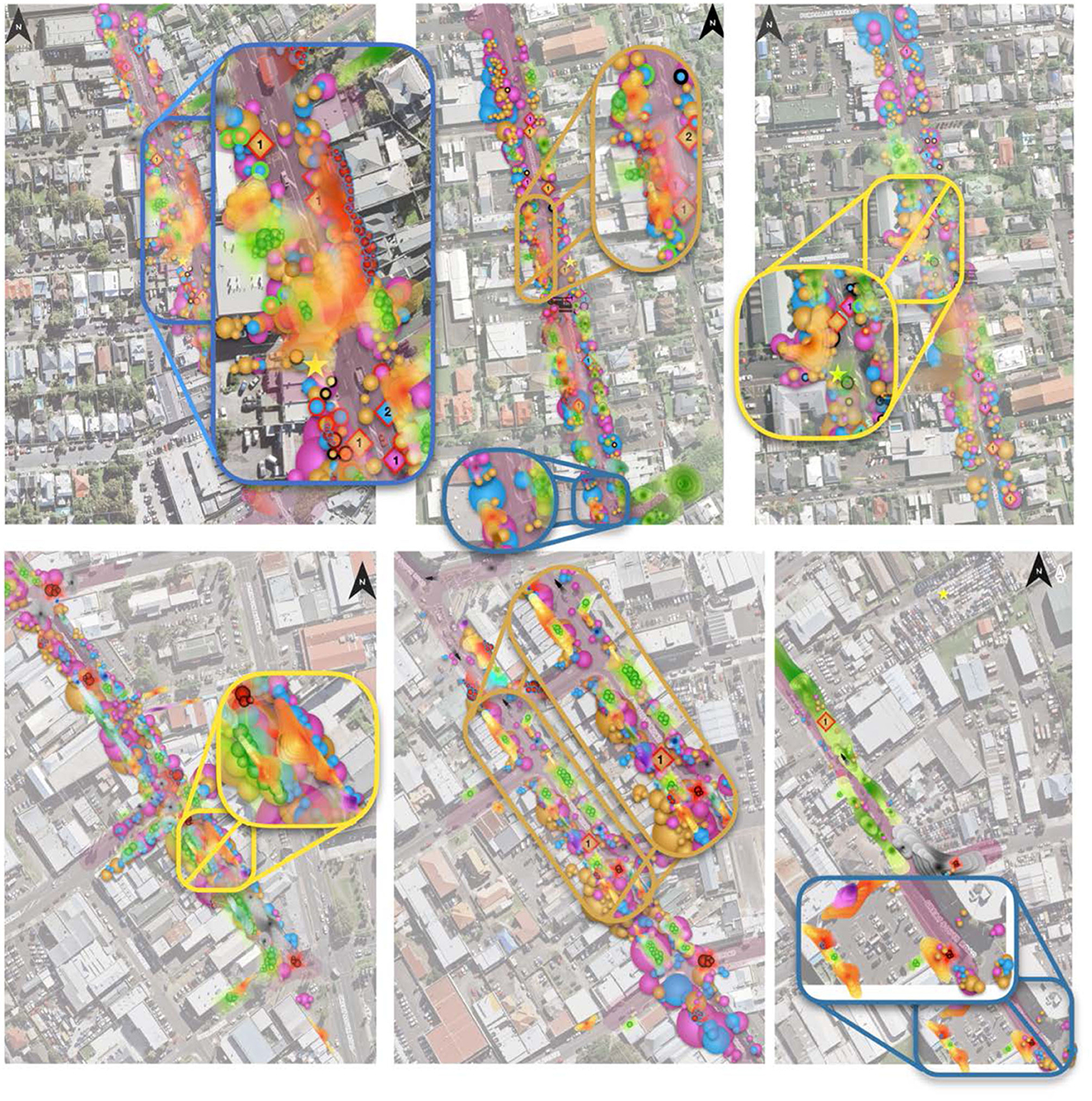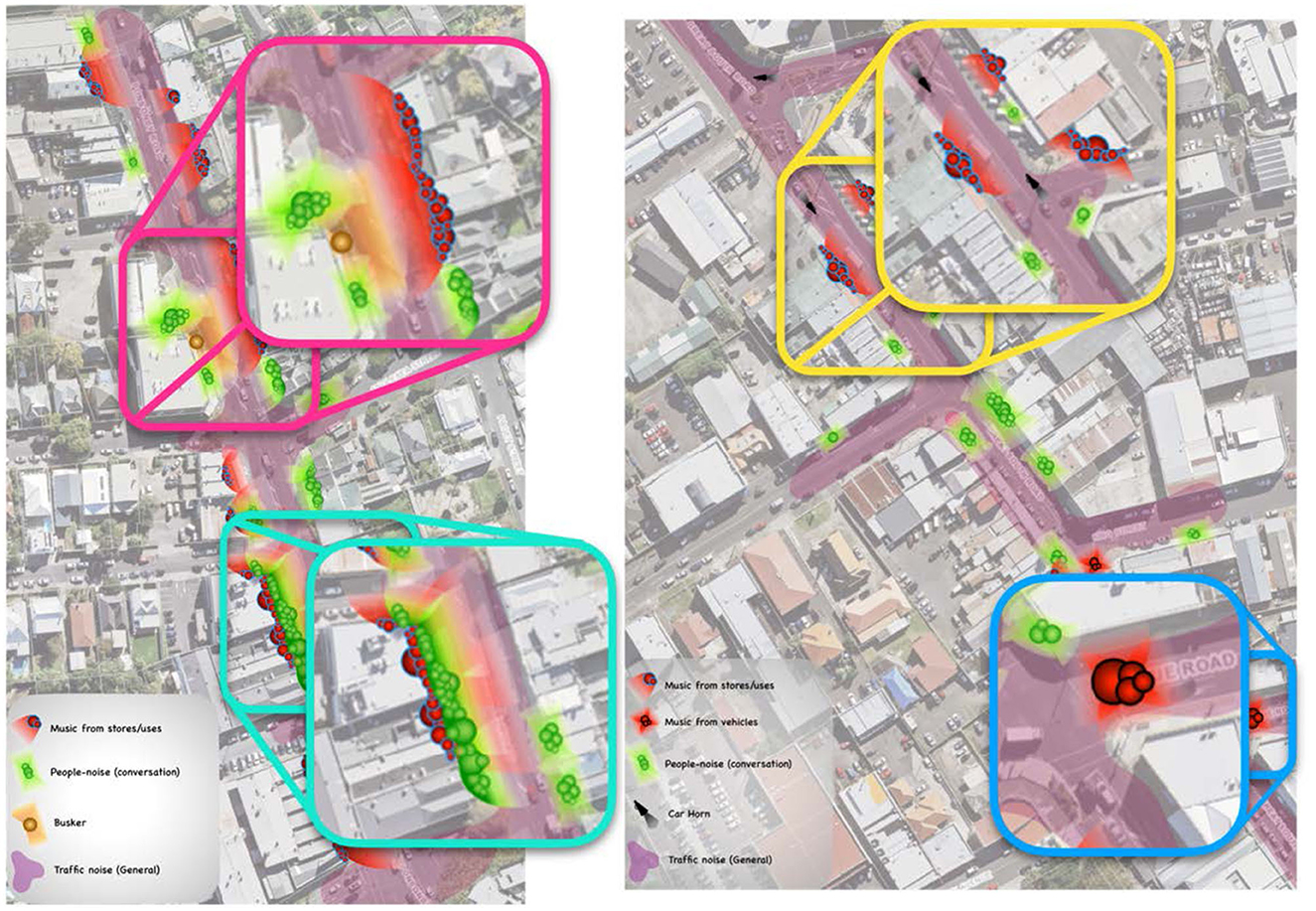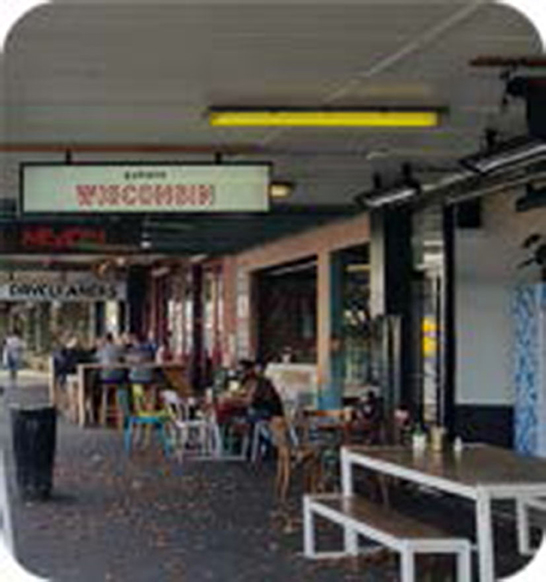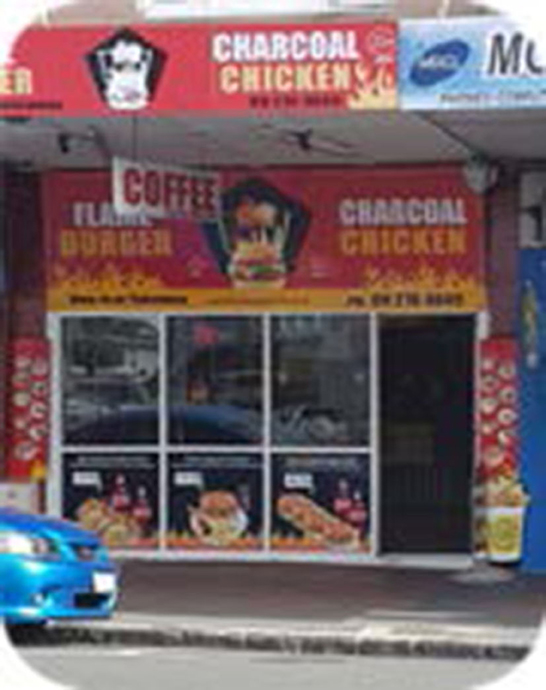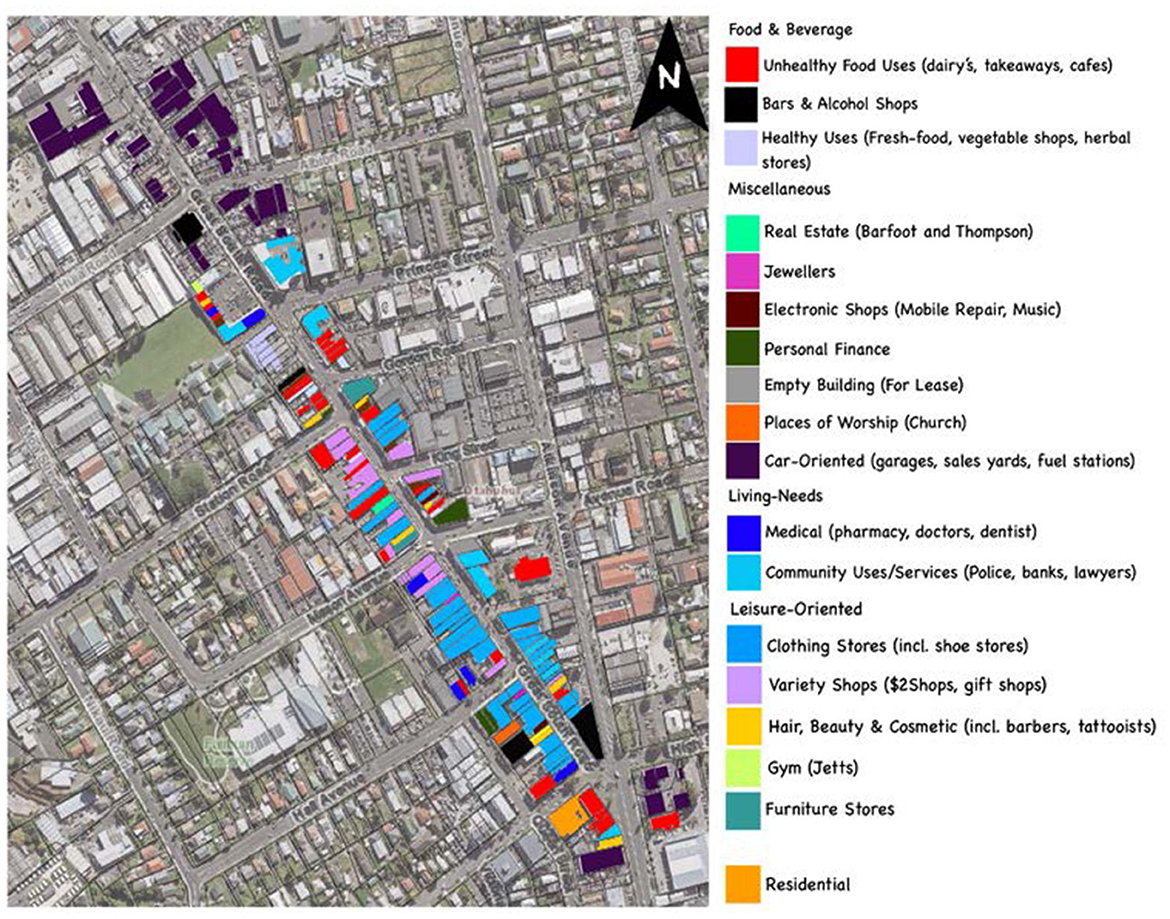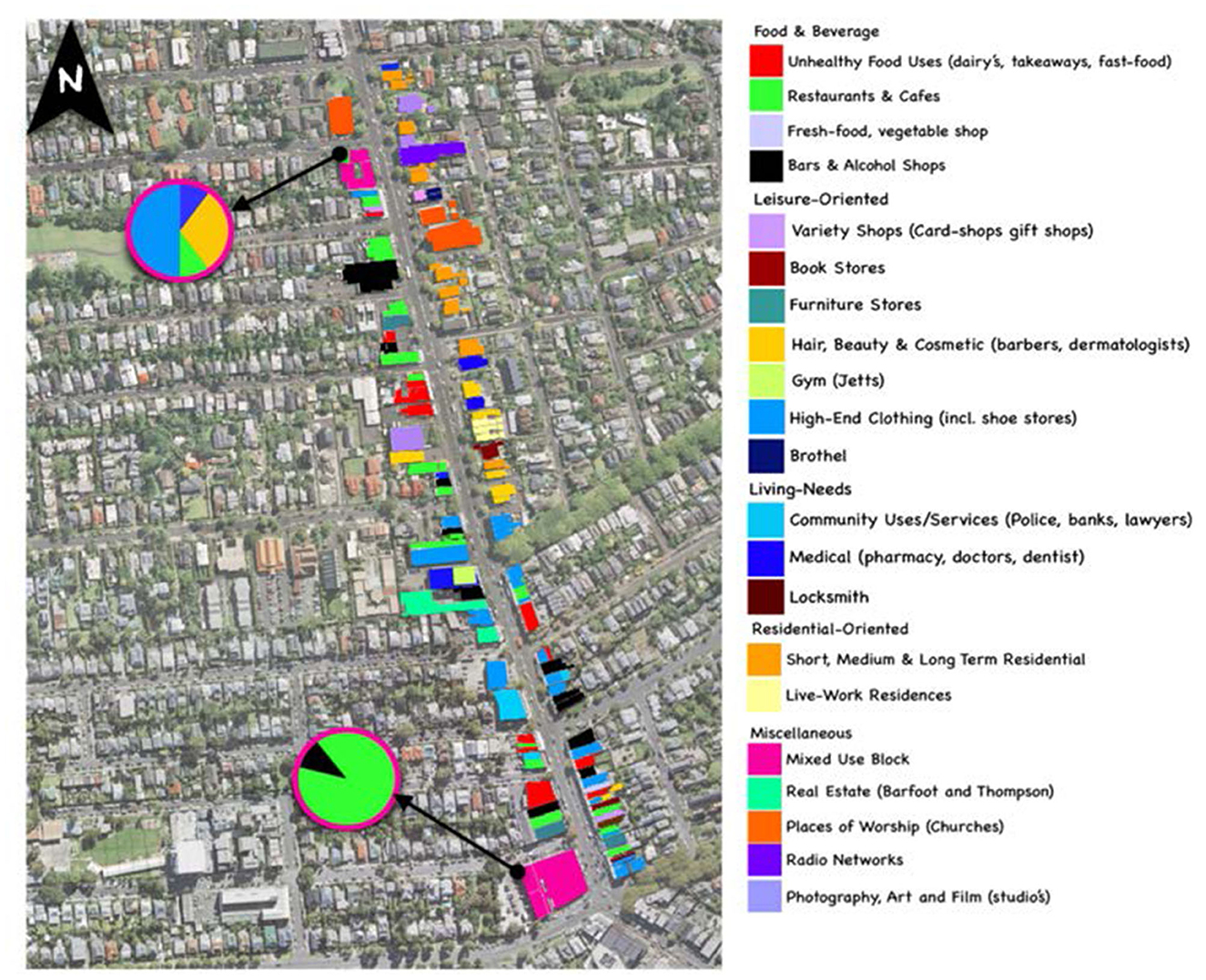Multi-sensory evaluation of urban design in creating obesity encouraging environments: The experience of town centres in Auckland, New Zealand
- 1Tamaki Regeneration Company, Auckland, New Zealand
- 2Auckland Design Office (Tamaki Makaurau Design Ope), Auckland Council, Auckland, New Zealand
- 3School of Architecture and Planning, University of Auckland, Auckland, New Zealand
This article presents a multi-sensory study on pedestrian activities in the public realm of two town centers in Auckland, New Zealand. We utilize mixed-method and multi-sensory evaluation methods, combined with sensory experience and activity mapping, to explore the effects of the obesity encouraging environment of town centers on the activity concentrations of pedestrians. We further discuss the influences of urban design and land use diversity on generating obesity encouraging environments of town centers. The article aims to provide a basis to initiate discussion around the importance of understanding the multiple-sensory experience of public space beyond merely sight sense which traditionally dominates urban design discipline. Furthermore, this article demonstrates the role and quality of sensory experience in shaping obesogenic behaviors within the built environment of two town centres; with a diversity of type and quality of land uses. It also highlights that the mere provision of urban morphology or built form factors linked with walking activities is not a precursor for healthier communities. Thus, the impacts of urban design and quality uses of the built environment on the multiple senses of the users should be considered in urban design research and practices.
1. Introduction
The literature has demonstrated the cause-and-effect relationship between the built environment characteristics and human health outcomes (e.g., Srinivasan et al., 2003; Rao et al., 2007; Codinhoto et al., 2009). Obesity is driven, in part, by the patterns of energy-dense food consumption and physical inactivity (World Health Organization, 2019a). Obesity encouraging environment quality is associated with the urbanisation processes and the resultant urban form structure (World Health Organization, 2019b). Urban fabric contains symbols about the relationship between people and space (Hull IV et al., 1994). When urban fabric possesses obesity encouraging qualities, the place or space may encourage food consumption and/or discourage physical activity (Reidpath et al., 2001, p. 142). The rise in the obesity ratio in cities or towns worldwide has significant implications for the conceptualization, design, management and use of urban spaces and the public realm.
The perceptual dimension of public space is a critical factor influencing the sense of place (Rodaway, 2002; Carmona, 2010) and habitual behavior including walkability (Koohsari et al., 2013; Mehta, 2014). Yet, in the urban design domain, the sight-sense relationship (i.e., what we see with our eyes) traditionally dominates the thinking of the perception, use and management of urban spaces (Lynch, 1960; Bentley et al., 1985; Araabi, 2016; Mediastika et al., 2020). The literature remains scarce to investigate the impacts of multiple senses of the urban environment (sound, visual, and olfactory senses) and the quality of uses on pedestrian activities in town centers. This study aims to add to this emerging and growing area of research within the urban design discipline.
In understanding “place,” the image of the city is shaped by a bombardment of sensory attributes which provide tacit knowledge (Truax, 2001 in Bruce et al., 2015, p. 3). It is in this missing dimension where one makes sense of the environment and develops responses through repetitive experience – that is, how one truly perceives place (Tuan, 1977; Engen, 1991; Carmona et al., 2003; Gehl, 2010). The sense of smell and sound enables space to have character attributes in which “place” exists (Tuan, 1977; Carmona et al., 2003; Thibaud, 2011). The habitual behavior loops are multi-layered, further emphasizing the complexities of our senses of space, its impact on the perceptions of space, activities within space and obesity health outcomes (Alfonzo, 2005; Mehta, 2008; Duhigg, 2012). As such, sound-scape and smell-scape are critical in shaping urban experience as it lends character to place, creating imageability (Tuan, 1977, p. 11) and triggering and maintaining emotional attachment and identity to place (Engen and Ross, 1973; Tuan, 1977; Cunningham et al., 1999; Xiao, 2018).
Revitalizing or transitioning urban environments that promote habitual behavior requires cognisance of behavioral science and users' multiple senses to inform urban design responses. This study highlights a distinction of space as an assemblage of the built components, while place is a sensory assemblage beyond merely what one sees and expands this to sounds and smells. These aspects collectively contribute to shaping behaviors and how humans interact and use built environments (Thaler and Sunstein, 2008; Gehl, 2010; Thibaud, 2011). As such, comprehension of the sensory dimensions of the built environment is of significant importance in understanding human health issues like obesity, noting that the visual sense is but one part of the sensory system of activity decision-making and environmental interaction (Mediastika et al., 2020).
Further, a number of earlier research findings have merely discussed the proximity to public space (e.g., Witten et al., 2008; Kaczynski et al., 2013) or provision of walkability-promoting factors (e.g., Floyd et al., 2011), which unveiled the need for more comprehensive understandings of the inherent multiple senses of human beings. The provision of active travel options within 800-meter ped-shed catchments is not solely a precursor for creating healthier communities (Allen et al., 2018). Improving users' perceptions and experiences require critical cognisance to sufficiently understand behavior and how space is used (Carmona et al., 2003; Mehta, 2008). However, they are less empirically examined and often neglected elements, partly because of the challenge it presents (Alfonzo, 2005; Mehta, 2008). This study seeks to focuses on the interactive characteristics of the built environment and the sensory experience of space and obesity as a construct of places (Jackson et al., 2004; Speck, 2018), by discussing the experience of two case examples in Auckland, New Zealand.
The following section provides an overview of the research progress of urban design, sensory experience and human behavior, and the influence of multiple-sense systems. The third section critically describes the multiple-sensory evaluation methodology and details the study cases and data collection methods. In the fourth section, this article presents the results of sense-based activity mapping. It also discusses the effects of the obesogenic qualities of town centers on the activity patterns of pedestrians. The last section explores the interactions between land use diversity, multiple senses of the town center environment, and the shaping of an obesogenic environment. It concludes the article by discussing the implications of this study.
2. Urban design, sensory experience, and behavior
2.1. Urban design and obesity encouraging environment
Walking is associated with positive pedestrian experiences and achieving public health outcomes (Healthy Auckland Together [HAT], 2018; New Zealand Transport Authority [NZTA], 2019). Globally, the importance of walkability has been reinforced by a large number of planners and designers for improving urban environment experiences, such as in cities in New Zealand, Australia, Canada and Europe (City of Melbourne, 2017; Gunn et al., 2017, p. 2; Auckland Council, 2019). This method is essentially at the core of the compact city concept, which underpins the prevailing planning or design strategies across a number of cities (Lee and Moudon, 2008; Raman, 2010; Gunn et al., 2017; Liu et al., 2021, 2022).
In the urban design domain, improving walkability and active travel experiences and qualities are usually aligned with the visual sense and “visual attraction” (Lynch, 1960; Bentley et al., 1985; Ewing et al., 2006; Sallis and Glanz, 2006; Zuniga-Teran et al., 2017), and visual experience of space in the “journey” through urban space. The visual sense influences the ability to “see” the built environment and create a visual image of place (Lynch, 1960; Bentley et al., 1985), reinforcing its characterization as a “far-space” sense (Wahurwagh and Wankhede, 2016, p. 742). However, sight sense is also associated with obesity-inducing effects, with evidence suggesting that the physical characteristics of space or place influence cognitive processing and behavioral responses (Duhigg, 2012; Elliot, 2015; Spence et al., 2016).
Physical attributes are often proposed with a perceptual or sensory argument, such as feelings of safety, essentially referencing the dimension of perception (Carmona et al., 2003; Ministry of Justice New Zealand, 2005). Colors and textures also influence such visual perception in terms of built aspects and behavioral eating patterns through inducing “visual-hunger” (Spence et al., 2016, p. 58). This is understood as the “natural desire, or urge… and the subsequent array of neural, physiological, and behavioral responses” to food exposure (Spence et al., 2016, p. 59). For example, colors stimulate various emotional responses (Elliot, 2015), whereby even the simple use of the color red stimulates hunger (Spence et al., 2016). Visual perception entails an influence beyond what one merely sees, resulting in behavioral responses (Elliot, 2015), which leads to “mindless activities” like eating (Thaler and Sunstein, 2008, p. 43).
Sound-scape is the acoustic environment perceived, understood or experienced by a person or user (Hilton and Xiao, 2019, p. 2). A city's soundscape contains expected or anticipated urban sounds (e.g., traffic noise from cars and/or busses, construction noise), which are stereotypically negative (Thibaud, 2011; Kurbatz, 2014; Bruce et al., 2015; Hilton and Xiao, 2019). However, the auditory sense can also be positive, such as the sound of other people indicating a sonic spatiality of public spaces (Hilton and Xiao, 2019, p. 2), which is known to attract or repel people from spaces or places (Hilton and Xiao, 2019). Additionally, soundscape plays an essential role in urban experience “to mediate site-specific activities” and increase “aesthetic sensation” (Hilton and Xiao, 2019, p. 2). In this respect, sound can potentially demarcate place or space into “acoustic territories” of activities, coupled with inherent qualities to transcend its influence beyond a rigid boundary (Hilton and Xiao, 2019, p. 14).
Thus, sounds have the potential to shape place-vitality and develop emotionally rich connections to a place (Carmona et al., 2003, p. 87). Additionally, the soundscape plays a significant role in the contextualization of place (identity/attachment) by way of evaluating the perceived sound environment (Hilton and Xiao, 2019, p. 2); implying a sound-perception of place (Carmona et al., 2003; Wahurwagh and Wankhede, 2016; Hilton and Xiao, 2019).
Smellscape, although lesser-studied than the other senses in the literature, especially in the urban design field, the sensitivity of smell enables meaning(s) to be associated or attributed to place (Tuan, 1977; Carmona et al., 2003; Kabat-Zin, 2014; Kurbatz, 2014). The critical influence of smell is that it is inseparable from the human olfactory perception system (Xiao, 2018, p. 242), as smell sense is directly connected to the brain's emotions and memory processing system; the limbic system (Engen, 1991; Cunningham et al., 1999).
Of particular importance in the discussions of the use of space and obesogenic behaviors [i.e., eating patterns and/or physical (in)activity] is the influence of smells on the habit-driven dimension. It is closely associated with memory and has been found to last longer in memory than visual-sense memory (Engen and Ross, 1973; McLean, 2016; Xiao, 2018). In this regard, while smell can define contextual boundaries, it can also provide an enriched image of the place and its associations (Lynch, 1960; Engen and Ross, 1973; Tuan, 1977; Kabat-Zin, 2014; Kurbatz, 2014; Xiao, 2018). This can lead to an alternative and invisible “olfactory map,” which enables the conceptualization of place “by way of smells” (Xiao, 2018, p. 246). This “olfactory map” can promote habituated behavior learned in another “place” (Tuan, 1977; Cunningham et al., 1999; Thaler and Sunstein, 2008; Spence et al., 2016) and provide “familiarity…gained through repetitive and constant detections of the smell over a long period of time” (Henshaw, 2013 in Xiao, 2018, p. 4).
Built environment characteristics ultimately “shape perceived characteristics” (Mouratidis, 2018, p. 31) through “sensory encounters” of the urban landscape (Degen and Rose, 2012, p. 3271); thereby influencing the experience of “place” (Lynch, 1960; Alfonzo, 2005; Taylor et al., 2014; Gunn et al., 2017). From the obesity lens, in public health and behavioral studies, smell-sense triggers eating behavior (Birch and Ventura, 2009; Duhigg, 2012). We would argue smell-perception is inherently tied to “place,” providing an invisible and alternative map, or image of context (Tuan, 1977; Cunningham et al., 1999; McLean, 2016; Xiao, 2018) to our understanding of space and further impacting on how people engage and action in urban spaces (Alfonzo, 2005).
2.2. The sense-system of influence
Perception is strongly correlated to the built environment and the resultant experience (Saelens and Handy, 2008). It is crucial not to disassociate it “from the concrete conditions in which it occurs” (Thibaud, 2011, p. 205). This also acknowledges the role of the sensory components of context in possessing a “pervasive quality” (Thibaud, 2011, p. 206), implying “experience” as “an interconnected whole” (Carmona et al., 2003, p. 87). Resultantly, the combination of the senses provides “memories of…space” (Hu and Chen, 2018, p. 3), which can resonate with both “individual and collective memory” (Wahurwagh and Wankhede, 2016, p. 741) and create place-based or triggered “sensory expectation” (Bruce et al., 2015, p. 2).
Predominantly, the research interests are placed on analyzing the relationships between visual sense (what we see) and the built environment (Mehta, 2008; Bruce et al., 2015; Quercia et al., 2015). This is because it has always been “challenging to quantify the relationship of the built environment with human emotional attachment” (Hu and Chen, 2018, p. 3). Nevertheless, it is evident that there are a number of attributes of the built environment that effect cognitive processing of human beings. This cognitive processing includes the senses working in tandem to shape experiences and, more importantly, behavioral responses to the built environment (Lynch, 1960; Whyte, 1980; Stamp, 2000; Carmona et al., 2003; Mehta, 2008; Wahurwagh and Wankhede, 2016; Hu and Chen, 2018). Thus, to understand what creates a (un)obesogenic environment, a critical cognisance is required for the “multi-sensory channels” (Hu and Chen, 2018, p. 3) beyond the visual-sense realm, for the comprehension of the holistic process of “gathering, organizing and making sense of the environment” (Carmona et al., 2003, p. 87).
Furthermore, the physical construct of what is “seen” in the space alone does not solely determine environmental interaction and subsequent behavioral response (Carmona et al., 2003; Mehta, 2008; Ernawati et al., 2018; Hu and Chen, 2018; Xiao, 2018). Such aspects can be characterized as and influenced by the normative human-behavioral process (Duhigg, 2012). For example, the smell and associated sight of fast food or takeaways could affect and/or trigger memories of context (built environment) and, thus, initiate “mindless” behavioral responses (such as eating or desire to eat) (Thaler and Sunstein, 2008, p. 43) associated with such a memory (Degen and Rose, 2012; Duhigg, 2012; Bruce et al., 2015; Hu and Chen, 2018) (see Figure 1). In essence, this reinforces how “space” and “contexts” refer to physical manifestations of the built environment, while “place” is an all-encompassing term which also describes the sensory associations to the built environment. For example, space or context is an assemblage of physical elements and functions (buildings, roads/streets, trees etc.), while the place is the sensory experience of this assemblage.
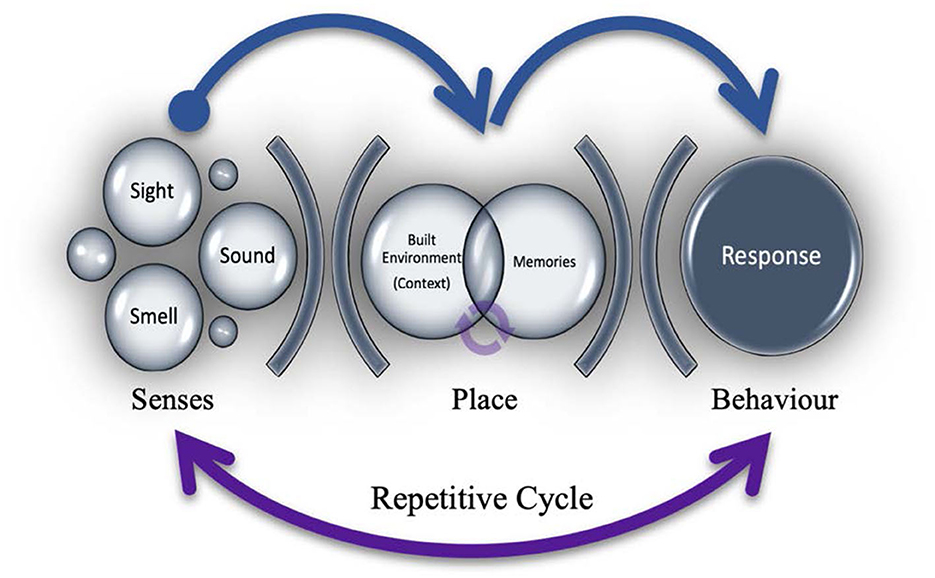
Figure 1. Sense-influence and behavioral response in the context of the built environment and memories.
Put simply, the senses enable the mental insights of the built environment to be gathered (Lynch, 1960; Stamp, 2000; Mehta, 2008; Thibaud, 2011; Degen and Rose, 2012; Araabi, 2016) and encompasses an influential role in how the place is perceived. In essence, these insights occur “through association” (Bruce et al., 2015, p. 3), and shape the understanding of “place” including both the identification and attachment (Carmona et al., 2003; Rollero and De Piccoli, 2010; Adams and Tiesdell, 2013; Hu and Chen, 2018). However, this paper is not intended to redefine place attachment or identity but rather explores these concepts in the context of creating obesogenic environments.
3. Methodology
3.1. Multiple-sensory evaluation method
The study deplored a mixed-method approach to explore the impacts of urban design in generating sight, sound and smell senses that create (un)obesogenic built environments by incorporating results from sense walks of two town centers in Auckland, New Zealand. A hybrid assessment model was developed to gain a holistic experience and enable an inter-experiential analysis of sight-oriented factors coupled with the sensory experience of sound and smell and how they further influence the activity concentrations of pedestrians.
3.2. Study cases and data collection
Inspired by studies of scholars such as William Whyte and Jan Gehl, this article utilizes the power of simple observation from which powerful conclusions are drawn (Elsheshtawy, 2015, p. 400). A customized adaptation of the analysis and techniques of Jan Gehl's public life survey (Gehl and Svarre, 2013) was developed and employed, mainly involving activity-mapping, observation, and activity quantification. Observational techniques were deployed, through comprehension of experience involved “sense-walks” being undertaken along a predetermined route (Bruce et al., 2015, p. 2) for each area, with a focus on smell and sound (Quercia et al., 2015; McLean, 2016; Hilton and Xiao, 2019), while also noting the impact of visual factors such as signage and color.
The spatial plan in Auckland (the Auckland Plan) provides a framework to direct the greater part of future growth to designated metropolitan, town and local centers. Town centers in the statutory land use plan (the Auckland Unitary Plan) are typically located on main arterial roads, with the aims to provide public transport access and areas for growth and intensification. The sensory experience of two town centers - Ponsonby Town Center (PTC) and Ōtāhuhu Town Center (OTC) are undertaken and analyzed. This enables investigation of urban design factors in generating built environments of town centers that (dis)stimulate obesity-related senses and consequent behaviors. The two areas were chosen given their physical and structural similarities (Table 1). Under the Auckland Unitary Plan, both town centers are designated for a similar scale of development by way of zoning. For the purposes of comparison, a reduced portion of the PTC township was assessed. This was deduced based on its distinctive character nodes. The two largest character nodes – Vandaleur Road and Franklin Junction intersecting Ponsonby Road at Cowan Street to Picton Street were selected for assessment (Auckland Council, 2018).
Gathering empirical data involved assessment of numerous ‘walkability-factors'. Utilizing observational techniques, the study undertakes a two-pronged, mixed-method analysis of both town centers, during two trips for both town centers. Comprehension of experience involved “sensewalks” was undertaken by the investigator along a predetermined route (Bruce et al., 2015, p. 2) for each township, including multiple senses on smell and sound (see Quercia et al., 2015; McLean, 2016; Hilton and Xiao, 2019). The activity-mapping exercise provided an observational evidence-base for subsequent analysis.
The sense walks provided an alternate understanding of walkability within the townships from the obesity lens, also considering the senses of walking rather than investigating the existence of factors of spaces to be walkable or accessible. Three observation points were determined for each town center area to ensure observational analyses was thoroughly undertaken (Figure 2). Each observation point involved a 15-minute stationary activity-mapping exercise over three independent periods at 9.48 am, 12.29 pm and 2.12 pm, following Jan Gehl's public life survey (see Gehl and Svarre, 2013).
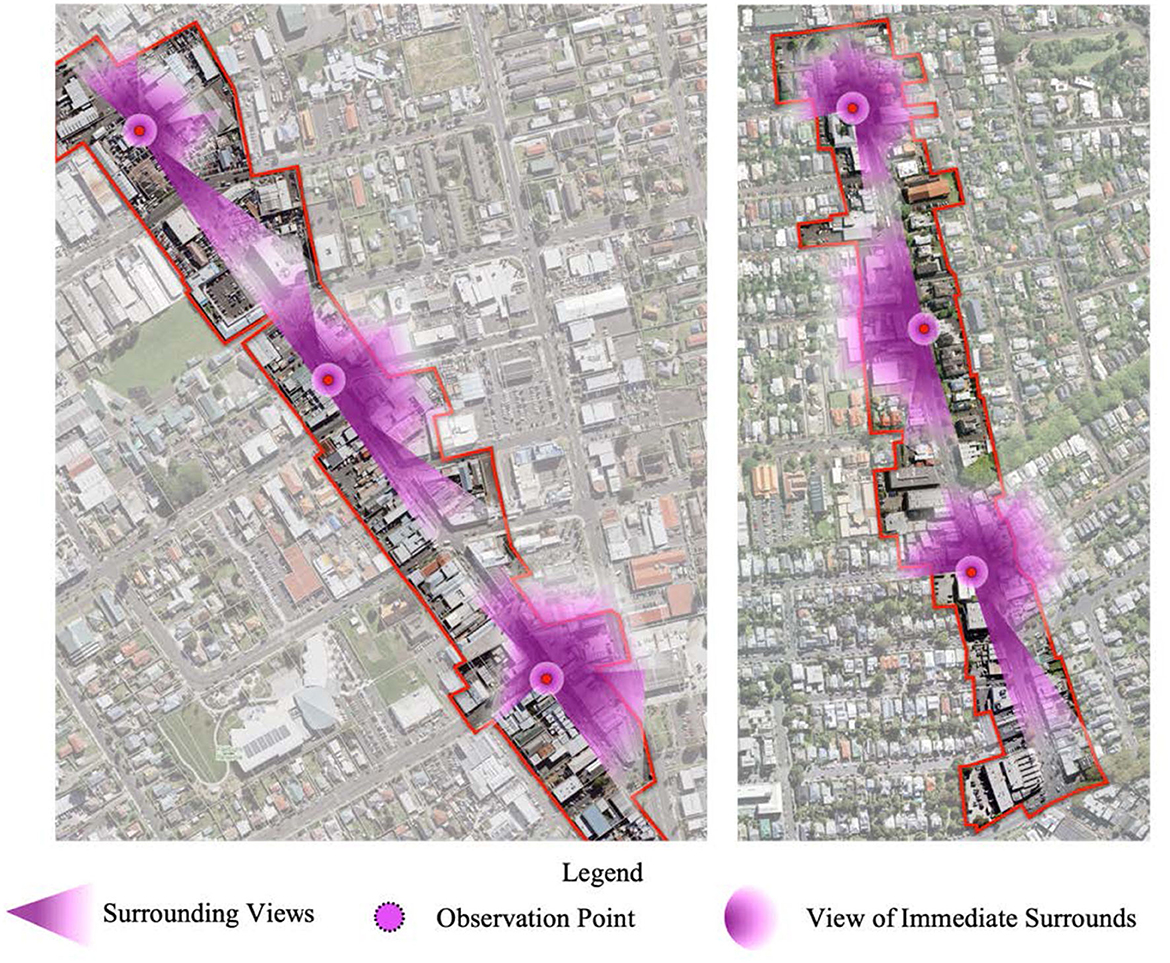
Figure 2. Observation points Ponsonby Road Town Centre (Left); Ōtāhuhu Town Centre (Great South Road), (Right) (Not to Scale).
The analyses on the land use diversity and uses of spaces were based on the desktop study of local council documents and records. These were complemented by self-identification and refinement by the author during the sense walks.
4. Results and findings
In order to explore multiple senses instead of merely sight-sense, an assemblage assessment framework involving three sensory attributes and influences of sight, sound and smell were discussed in the context of the Ōtāhuhu Town Center (OTC) and the Ponsonby Town Center (PTC).
4.1. The smell-scape and activity-concentrations
The sense-walks were assessed as an overarching lens of “experience'. In the OTC, food smells were frequently likened to heated or hot oil and grease and were reflective of an almost homogenized foodscape (Figure 3). However, in the PTC, the smell-sense walk noted not only various food items (e.g., coffee, beer, burgers) but also distinct, ingredient-based smells (cardamon, pepper) (Figure 3). This demonstrates “place” has an associated olfactory map, but also, smell acts as a spatial marker of places through the quality of their foodscape (Quercia et al., 2015; McLean, 2016).
In the OTC, the presence of “food smells” was dominant and illustrates a spatial association of activity concentration (Figure 4). With regard to the PTC, however, smells are associated with coffee, food, and even alcohol, which implies a different “cultural landscape” between the two townships, and this is differentiated by the foodscapes (Figure 4). Overlaying sense-walk results with activity patterns illustrates an association between food smells and activity patterns (Figure 4). The smell-scape, coupled with activity concentrations, demonstrated clear associations with regard to how both townships are smell-sensed and its activity patterns.
4.2. Results from the sound-walk
The sound-scape analysis results presented relatively inconclusive findings in which the associations between sound-scape and activity patterns were weak in both townships (Figure 5). However, it is worth noting that traffic noise along Ponsonby Road and Great South Road (Ōtah̄uhu) appears to have minimal disturbance with regard to the enjoyment of and activity within the townships. This probably can indicate the acceptance of trade-off traffic noise for place attachment, whereby the familiarity with sounds are linked to the experience of the space and is considered less noisy than “people less affectively linked” (Rollero and De Piccoli, 2010, p. 200).
Similarly, the “people factor” was also evident in the sense-walking. In the OTC, there was a diverse sound-scape of conversations taking place not only in various locations but also in various languages. However, in the PTC, the sound-scape of conversations was typically “structured,” and linguistic diversity was almost absent.
4.3. Sight
In the PTC, street furniture associated with its foodscape is common (Figure 6). However, in OTC, the foodscape is “internalized”; absorbed within the building. This suggested that the food environment in OTC was somewhat “concealing” or “hiding” its patrons from the street; with red-dominant colors (Figure 7) and differences in target markets, providing a degree of comfort in consuming unhealthy food indoors. In addition, the signage of most unhealthy food sources was easily noticeable. This demonstrated how the built environment potentially induces eating behavior via blatant and visual reinforcements (i.e., using color-red signage).
Signage and facades also reflected the critical disparity of sight sense between the two townships. The PTC displayed well-maintained facades (including heritage facades) and signage. However, the heritage attributes of the OTC were shielded, and “concealed” by faded and dilapidated store signage.
4.4. Land use diversity and quality of uses
The land use analysis demonstrates both townships providing diverse land uses (Figures 8, 9), as is the nature of town centers (Gunn et al., 2017). However, the higher homogeneity of land uses in OTC (than in PTC) reflects the association between obesity encouraging environment, land use diversity, and the quality of uses.
The difference in the quality of uses of space between these two townships illustrated the importance of space for creating an obesity behavior-inducing environment. For example, in the OTC, a café often provides unhealthy food, whilst, in the PTC, cafes are “typical” to their common description as “a small restaurant selling light meals and drinks” (Oxford University Press, 2019). This reflects the spatiality of obesity. The experience of space was reinforced through repetitive exposures and sensory stimulation (Pearce et al., 2008; Jolly, 2011; Spence et al., 2016).
5. Discussion
The findings of this article demonstrate the activity patterns in the experience of the chosen town centers are closely associated with the sound and smell senses, in addition to the sight senses. Furthermore, this study presents a finding in which the quality of smells is reflective of the quality of the foodscape and how “place” has an associated olfactory map. The street environment and the related land-uses also reflected differentiation in creating an obesogenic environment. The results illustrate that despite both townships naturally anticipating higher levels of walkability, the PTC is considered a less obesogenic environment than OTC, despite their physical and structural similarities and planning aspirations.
This article reinforces findings from other studies, particularly regarding the impacts of land use diversity and quality use of spaces on an obesity-inducing environment. This indicates that the built environment's quality experience is critical in pedestrian activities and human health. The assessment and considerations of the built environment should not just consider the provision or interrelationships of health-contributing factors or elements but, perhaps more importantly, the quality and experience of these obesity-contributing environments or the components of the built environment.
A notable finding reinforced in this article is that sensory factors cannot exist or be considered alone. Instead, this reflects a networked system of sense influencing urban environments, promoting activity patterns and further eating behaviors. This finding highlights that the quality of the built environment for walkability is riddled with layers of complexity, which cannot be addressed, nor exist, in isolation (Alfonzo, 2005; Ewing et al., 2006; Mehta, 2008). Walkability is inherently a sought-after quality of all cities. However, simply providing walking options neglects the influences of sensory experience contributing to obesity-inducing built environments (or not). This paper also further highlights the importance of considering the multiple-senses of experience rather than merely the sight sense in the urban design domain. Herein lie numerous complexities of the sensory realm, interwoven to form the understanding of “place” and all its emotive associations (attachment, identity etc.). Hence, mere walking enables environmental interaction and determines the users' activities, movements and habitual behaviors (e.g., eating). In this regard, the spatiality of neighborhoods is a significant determinant of obesity.
This article not only challenged (1) the premise that the mere “existence” of these factors positively correlated to activity-promoting environments but also (2) that assessing inter-relationships between factors requires a “purposed-lens” (in this case, an obesity-lens). Essentially, this demonstrated how “place” is a “socio-physical construct” (Carmona, 2019, p. 1), which enables explanations of “how people establish preferences and make choices” (Carmona, 2019, p. 2).
The findings from the study are crucial in understanding the spatiality of the senses and the “place affect,” which cultivates obesity. In essence, the two town centers provided different holistic experiences, despite having spatial similarities in structure and planning zoning. The disparities of the smell sense indicate the quality of the foodscape offers distinctions for the township's olfactory map, illustrating the invisibility of senses in creating the “image of the town centre'. Thus, vastly different interactions occur between people and places, which formulates distinct (un)obesogenic behavior loops. The article negates the simple and mere provision of built factors that are sufficient in creating walking-conducive town center environments.
6. Conclusion
Adopting a mixed multiple-sense methodology, this study undertakes case studies and observational techniques to explore the influence of the perceptual or sensory realm. In particular, sound and smell (in relation to sight) provide a more comprehensive understanding between environmental interaction, walking experience and the shaping of an obesogenic environment. The study combines land use diversity and sensory experience, including sound, smell, and sight, in determining its interplays which reflect the obesogenic attributes of the town centre's built environment. In the walkable environment of these two town centers with physical and structural similarities, urban design and quality uses of the built environment can affect the multiple senses of users that lead to distinct encouraging or discouraging obesity encouraging environments.
The findings cite the difficulty of understanding the perceptual dimension, yet acknowledge its importance in urban design. The study also uncovers the role of the sensory experience of the built environment and its associations with obesity-conductive environments. From this analysis in Auckland, the article demonstrates the quality of obesity-(dis)encouraging factors are more important and closely related to the experience and habitual behavior. Furthermore, it reveals that the physical walking facilities and quality of experience within these settings can shape obesity encouraging environment qualities and associated behaviors. Essentially, the paper provides a basis to initiate discussion around the importance of the sensory experience, beyond mere sight sense, in addressing the obesity-promoting environment and how we should consider these sensory experiences in the design of town centers and public spaces.
While this study provides an initial basis for further investigations, it is worthwhile to investigate further the perceptions of frequent users of the two townships, thus to validate the certainty of the correlations between multiple-sensory experience with obesogenic-behavior encouraging environments. This can complement this study by further understanding the subjective perceptions of the space and built environment and the associated behavior changes. Also, this study intends to consider land use and built environment qualities in affecting multiple senses and subsequent behavior. Further studies are also needed to discuss the influences of natural processes and variables on smell-senses, such as weather conditions and wind strength.
Essentially, however, this research intends to link multiple-sensory experience with urban design quality and obesity-encouraging environment. Future case studies within similar contexts and built environment characters can potentially utilize the methods developed in this study, along with a longitudinal and user-focused data collection process. It also provides a basis analysis for further studies on advancing or validating methods or tools to assess obesity-encouraging built environment quality, according to multiple sensory experiences.
Data availability statement
The original contributions presented in the study are included in the article/supplementary material, further inquiries can be directed to the corresponding author.
Author contributions
JP and LB contributed to conception and design of the study. JP wrote the original manuscript. LB and WL contributed to compilation and revision of the submitted version. All authors contributed to the article and approved the submitted version.
Conflict of interest
JP was employed by the Auckland Urban Design Office, Auckland Council and Tamaki Regeneration Company.
The remaining authors declare that the research was conducted in the absence of any commercial or financial relationships that could be construed as a potential conflict of interest.
Publisher's note
All claims expressed in this article are solely those of the authors and do not necessarily represent those of their affiliated organizations, or those of the publisher, the editors and the reviewers. Any product that may be evaluated in this article, or claim that may be made by its manufacturer, is not guaranteed or endorsed by the publisher.
References
Adams, D., and Tiesdell, S. (2013). Shaping Places: Urban Planning, Design and Development. London: Routledge.
Alfonzo, M. (2005). To walk or not to walk? The hierarchy of walking needs. Environ. Behav. 37, 808.−836. doi: 10.1177/0013916504274016
Allen, N., Haarhoff, E., Beattie, L. (2018). Enhancing liveability through urban intensification: the idea and role of neighbourhood. Cog. Soc. Sci. 4, 17. doi: 10.1080/23311886.2018.1442117
Araabi, H. (2016). A typology of urban design theories and its application to the shared body of knowledge. Urban Design Int. 21, 11–24. doi: 10.1057/udi.2015.6
Auckland Council (2018). Ponsonby Road Plan. Available online at: https://www.aucklandcouncil.govt.nz/plans-projects-policies-reports-bylaws/our-plans-strategies/place-based-plans/Pages/ponsonby-road-plan.aspx (accessed March 29, 2019).
Auckland Council (2019). Building Strong Urban Centres and Neighbourhoods. Available online at: https://www.aucklandcouncil.govt.nz/plans-projects-policies-reports-bylaws/our-plans-strategies/auckland-plan/development-strategy/growth-urban-auckland/Pages/building-strong-urban-centres-neighbourhoods.aspx (accessed April 10, 2019).
Bentley, I., Alcock, A., Murrain, P., McGlynn, S., and Smith, G. (1985). Responsive Environments. A Manual for Designers. Oxford: Architectural Press.
Birch, L., and Ventura, A. (2009). Preventing childhood obesity: what works? Int. J. Obesity 33, S74–S81. doi: 10.1038/ijo.2009.22
Bruce, N., Condie, J., Henshaw, V., and Payne, S. R. (2015). Analysing olfactory and auditory sensescapes in English cities: Sensory expectation and urban environmental perception. Ambiances. Environ. Sensible Architecture et Espace Urbain. doi: 10.4000/ambiances.560
Carmona, M. (2019). Place value: place quality and its impact on health, social, economic and environmental outcomes. J. Urban Design 24, 1–48. doi: 10.1080/13574809.2018.1472523
Carmona, M., Heath, T., Oc, T., and Tiesdell, S. (2003). Public Places–Urban Spaces: The Dimensions of Urban Design. Oxford: Architectural Press.
City of Melbourne (2017). Walking Plan 2014–2017. Available online at: https://www.melbourne.vic.gov.au/SiteCollectionDocuments/walking-plan-2014-17.pdf (accessed April 16, 2019).
Codinhoto, R., Tzortzopoulos, P., Kagioglou, M., and Aouad, G. (2009). The impacts of the built environment on health outcomes. Facilities 27, 138–151. doi: 10.1108/02632770910933152
Cunningham, A. M., Manis, P. B., Reed, R. R., and Ronnett, G.V. (1999). Olfactory receptor neurons exist as distinct subclasses of immature and mature cells in primary culture. Neuroscience 93, 1301–1312. doi: 10.1016/S0306-4522(99)00193-1
Degen, M., and Rose, G. (2012). The sensory experiencing of urban design: the role of walking and perceptual memory. Urban Studies J. 49, 3271–3287. doi: 10.1177/0042098012440463
Elliot, A. (2015). Color and psychological functioning: a review of theoretical and empirical work. Front. Psychol. 6, 1–8. doi: 10.3389/fpsyg.2015.00368
Elsheshtawy, Y. (2015). Observing the public realm: William Whyte's ‘the social life of small urban spaces'. Built Environ. 41, 399–411. doi: 10.2148/benv.41.3.399
Engen, T., and Ross, B. (1973). Long-term memory of odors with and without verbal descriptions. J. Exp. Psychol. 100, 221–227. doi: 10.1037/h0035492
Ernawati, J., Surjono, H., and Sudarmo, B. (2018). People's preferences of urban design qualities for walking on a commercial street. IOP Conf. Series Earth Environ. Sci. 126, 1–9. doi: 10.1088/1755-1315/126/1/012206
Ewing, R., Handy, S., Brownson, R., and Clemente, O. (2006). Identifying and measuring urban design qualities related to walkability. J. Phys. Activity Health 3, S223–S240. doi: 10.1123/jpah.3.s1.s223
Floyd, M. F., Floyd, J. N., Bocarro, W. R., Smith, P. K., Baran, R. C., Moore, N. G., et al. (2011). Park-based physical activity among children and adolescents. Am. J. Prev. Med. 41, 258–265. doi: 10.1016/j.amepre.2011.04.013
Gunn, L., Mavoa, S., Boulange, C., Hooper, P., Kavanagh, A., Giles-Corti, B., et al. (2017). Designing healthy communities: creating evidence on metrics for built environment features associated with walkable neighbourhood activity centres. Int. J. Behav. Nutr. Phys. Activity 14, 164–176. doi: 10.1186/s12966-017-0621-9
Healthy Auckland Together [HAT] (2018). Monitoring Report 2018. Available online at: http://www.healthyaucklandtogether.org.nz/assets/Summary-Reports/Healthy-Auckland-Together-Monitoring-Report-2018.pdf (accessed April 10, 2019).
Henshaw, V. (2013). Urban Smellscapes: Understanding and Designing City Smell Environments. London: Routledge.
Hilton, A., and Xiao, J. (2019). An investigation of soundscape factors influencing perceptions of square dancing in urban streets: a case study in a county level city in China. Int. J. Environ. Res. Pub. Health 16, 840–857. doi: 10.3390/ijerph16050840
Hu, M., and Chen, R. (2018). A framework for understanding sense of place in an urban design context. Urban Sci. 2, 34. doi: 10.3390/urbansci2020034
Hull IV, R. B., Lam, M., and Vigo, G. (1994). Place identity: symbols of self in the urban fabric. Landsc. Urban Plan. 28, 109–120.
Jackson, R., Frank, L., and Frumkin, H. (2004). Urban Sprawl and Public Health: Designing, Planning, and Building for Healthy Communities. Washington, DC: Island Press.
Jolly, R. (2011). Marketing Obesity? Junk Food, Advertising and Kids. Available online at: https://www.aph.gov.au/About_Parliament/Parliamentary_Departments/Parliamentary_Library/pubs/rp/rp1011/11rp09 (accessed April 4, 2019).
Kaczynski, A. T., Kaczynski, L. R., Potwarka, B. J. A., and Smale, M. E. (2013). Association of Parkland proximity with neighborhood and park-based physical activity: variations by gender and agleisure sciences. Interdisciplinary J. 31, 174–191. doi: 10.1080/01490400802686045
Koohsari, M. J., Karakiewicz, J. A., and Kaczynski, A. T. (2013). Public open space and walking: the role of proximity, perceptual qualities of the surrounding built environment, and street configuration. Environ. Behav. 45, 706–736. doi: 10.1177/0013916512440876
Kurbatz, B. (2014). Urban smellscapes: understanding and designing city smell environments. The AAG Rev. Books 2, 99–101. doi: 10.1080/2325548X.2014.919152
Lee, C., and Moudon, A. (2008). Neighbourhood design and physical activity. Building Res. Inf. 36, 395–411. doi: 10.1080/09613210802045547
Liu, W., Beattie, L., and Haarhoff, E. (2021). Outcome-focused plan discretion for facilitating residential intensification: Exploring the insights and experience of property developers and planners. Land Use Policy 109, 105607.
Liu, W., Beattie, L., and Haarhoff, E. (2022). Residential intensification through a new statutory plan in Auckland: outcome evaluation and stakeholders' experience. Urban Res. Pract. 15, 724–745.
McLean, K. (2016). Towards a visual voice for smells. Landscape Arch. Front. 4, 131–141. doi: 10.1093/qje/qjv046
Mediastika, C. E., Sudarsono, A. S., Kristanto, L., Tanuwidjaja, G., and Sunaryo, R. G. (2020). Appraising the sonic environment of urban parks using the soundscape dimension of visually impaired people. Int. J. Urb. Sci. 24, 216–241. doi: 10.1080/12265934.2020.1713863
Mehta, V. (2008). Walkable streets: pedestrian behavior, perceptions and attitudes. J. Urban. Int. Res. Sust. 1, 217–245. doi: 10.1080/17549170802529480
Mehta, V. (2014). Evaluating public space. J. Urban Design 19, 53–88. doi: 10.1080/13574809.2013.854698
Ministry of Justice New Zealand (2005). National Guidelines for Crime Prevention Through Environmental Design in New Zealand. Part 1: Seven Qualities for Safer Places. Available online at: https://www.justice.govt.nz/assets/Documents/Publications/cpted-part-1.pdf (accessed April 14, 2019).
Mouratidis, K. (2018). Rethinking how built environments influence subjective well-being: a new conceptual framework. J. Urban Int. Res. Placemaking Urban Sustain. 11, 24–40. doi: 10.1080/17549175.2017.1310749
New Zealand Transport Authority [NZTA] (2019). The Pedestrian Experience. Available online at: https://www.nzta.govt.nz/assets/resources/the-pedestrian-experience/The-pedestrian-experience-literature-review.pdf (accessed April 15, 2019).
Oxford University Press (2019). Café. Available online at: https://en.oxforddictionaries.com/definition/cafe (accessed May 01, 2019).
Pearce, J., Day, P., and Witten, K. (2008). Neighbourhood Provision of food and alcohol retailing and social deprivation in urban New Zealand. Urban Policy Res. 26, 213–227. doi: 10.1080/08111140701697610
Quercia, D., Schifanella, R., Aiello, L., and McLean, K. (2015). Smelly Maps: The Digital Life of Urban Smellscapes. Available online at: https://researchswinger.org/publications/icwsm15_smell.pdf (accessed March 23, 2019).
Raman, S. (2010). Designing a liveable compact city: physical forms of city and social life in urban neighbourhoods. Built Environ. 36, 63–80. doi: 10.2148/benv.36.1.63
Rao, M., Prasad, S., Adshead, F., and Tissera, H. (2007). The built environment and health. The Lancet 370, 1111–1113. doi: 10.1016/S0140-6736(07)61260-4
Reidpath, D., Burns, C., Garrard, J., Garrard, M., and Townshend, M. (2001). An ecological study of the relationship between social andenvironmental determinants of obesity. Health Place 8, 141–145. doi: 10.1016/S1353-8292(01)00028-4
Rollero, C., and De Piccoli, N. (2010). Does place attachment affect social well-being? Rev. Eur. Psychol. Appl. 60, 233–238. doi: 10.1016/j.erap.2010.05.001
Saelens, B. E., and Handy, S. L. (2008). Built environment correlates of walking: a review. Med. Sci. Sports Exercise 40, 550. doi: 10.1249/MSS.0b013e31817c67a4
Sallis, J., and Glanz, K. (2006). The role of built environments in physical activity, eating, and obesity in childhood. The Future Children 16, 89–108. doi: 10.1353/foc.2006.0009
Speck, J. (2018). Walkable City Rules: 101 Steps to Making Better Places. New York, NY: Island Press.
Spence, C., Okajima, K., Cheok, A., Petit, O., and Michel, C. (2016). Eating with our eyes: from visual hunger to digital satiation. Brain Cognit. 110, 53–63. doi: 10.1016/j.bandc.2015.08.006
Srinivasan, S., O'Fallon, L. R., and Dearry, A. (2003). Creating healthy communities, healthy homes, healthy people: initiating a research agenda on the built environment and public health. Am. J. Pub. Health 93, 1446–1450. doi: 10.2105/AJPH.93.9.1446
Stamp, A. (2000). Psychology and the Aesthetics of the Built Environment. New York, NY: Kluwer Academic Publishers.
Taylor, W., Upchurch, S., Brosnan, C., Selwyn, B., Nguyen, T., Villagomez, E., et al. (2014). Features of the built environment related to physical activity friendliness and children's obesity and other risk factors. Pub. Health Nursing 31, 545–555. doi: 10.1111/phn.12144
Thaler, R., and Sunstein, C. (2008). Nudge: Improving Decisions About Health, Wealth and Happiness. Amsterdam Law Forum; HeinOnline: Online. p. 89.
Thibaud, J. (2011). The sensory fabric of urban ambiances. The Senses Soc. 6, 203–215. doi: 10.2752/174589311X12961584845846
Tuan, Y. (1977). Space and Place: The Perspective of Experience. Minneapolis, MN: University of Minnesota Press.
Wahurwagh, A., and Wankhede, K. (2016). The sensory experience and perception of urban space. Int. J. Emerg. Technol. 7, 741–744. Available online at: https://www.researchtrend.net/ijet/pdf/127-96.pdf
Witten, K., Hiscock, R., Pearce, J., and Blakely, T. (2008). Neighbourhood access to open spaces and the physical activity of residents: a national study Prev. Med. 47, 299–303. doi: 10.1016/j.ypmed.2008.04.010
World Health Organization (2019a). Obesity and Overweight. Available online at: https://www.who.int/en/news-room/fact-sheets/detail/obesity-and-overweight (accessed May 5, 2019).
World Health Organization (2019b). Obesity. Available online at: https://www.who.int/topics/obesity/en/ (accessed May 5, 2019).
Xiao, J. (2018). Smell, Smellscape and Place-Making in Perception-driven Approaches to Urban Assessment and Design. Hershey: IGI Global, 240–298.
Keywords: perceptual dimension, multi-sensory experience, urban design, obesity, land use diversity, walkability, Auckland
Citation: Parekh J, Liu W and Beattie L (2023) Multi-sensory evaluation of urban design in creating obesity encouraging environments: The experience of town centres in Auckland, New Zealand. Front. Sustain. Cities 5:1178056. doi: 10.3389/frsc.2023.1178056
Received: 02 March 2023; Accepted: 21 September 2023;
Published: 24 October 2023.
Edited by:
Thomas Krafft, Maastricht University, NetherlandsReviewed by:
Yuliang Chen, Guangxi University of Technology, ChinaTracie Barnett, McGill University, Canada
Copyright © 2023 Parekh, Liu and Beattie. This is an open-access article distributed under the terms of the Creative Commons Attribution License (CC BY). The use, distribution or reproduction in other forums is permitted, provided the original author(s) and the copyright owner(s) are credited and that the original publication in this journal is cited, in accordance with accepted academic practice. No use, distribution or reproduction is permitted which does not comply with these terms.
*Correspondence: Lee Beattie, l.beattie@auckland.ac.nz
 Jayesh Parekh
Jayesh Parekh Wen Liu
Wen Liu Lee Beattie
Lee Beattie